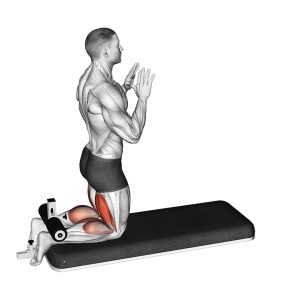Hamstring Injuries Are The Bain of Every Sports Persons Life
Essential Advice For Players & Coaches
Hamstring injuries are notoriously tricky to get right. They have a high recurrence rate and result in key players missing significant amounts of training and in worse cases losing their place on the team.
This fact is supported in the scientific research. Reinjury figures are ranging from twenty two to thirty four percent for that injury with other longer term studies demonstrating a four times increased risk in repeat injury with each episode of hamstring strain.
So if you have had two hamstring tears over the last year you are then four times more likely to reinjury it again for each injury. Yes! That is four multiplied by four, which is actually sixteen more times at risk to this type of injury again.
Understanding Hamstring Muscles - Essential Anatomy

Hamstring or Hamstrings isn’t one muscle but in fact 3 muscles bundled together. They’re the muscles at the back of the thigh. They span across 2 joints, the knee and the hip.
The upper attachment starts at the bone you typically sit on, called the Ischial Tuberosity, attaching then via the long muscle tendon portions to cross the back of the knee joint. One part is on the outer side (Biceps Femoris (BF) and Two parts are on the inside Semimembranosus (SM) & Semitendinosus (ST). This anatomical set up allows them to be involved in any combination of knee flexion and hip extension actions.
The fact the hamstring muscles have to cross two joints makes them potentially higher risk of injury, compared to muscles that only cross one joint.
The other key point here is that there is only one outside hamstring (BF) , and the two inside portions (SM & ST). With that, it is no surprise that the Biceps Femoris hamstring muscle is the one that gets strained more frequently.
How A Hamstring Injury Happens. ‘Is it torn or just a tweak’?
This is a comment people often make in the clinic. In essence a tweak is a tear. There are different degrees of muscle injury ranging from grade 1 (with a few fibers torn) to grade 3 which is a complete tear of the involved hamstring muscle or part thereof, such as the tendon or musculotendinous junction (MTJ).
A tear results in mechanical failure of that part of the tissue. In simple language there is too much strain (force) going through that part of the body at the time of injury and the muscle tore because it could not tolerate it.
The hamstring muscle and tendon can also tear because of overload. Overload is where the athlete is either working at an intensity beyond their capacity which results in a muscle strain.
Muscle overload can also occur due to over training where the player is training and playing too many games without allowing for adequate rest. This type of problem can happen over a few weeks as the intensity and the number of sessions per week increases.
Essential Advice For Hamstring Injuries - Why Not Do What theThe Pros Do?
The good news is there are a few key areas that you should focus on. My top four are the following.
1. High Speed Running

Ironically people with muscle injuries, particularly hamstrings, tend to do one of the following. They either avoid high intensity running entirely so the injured muscle never gets strong enough or they simply throw themselves back into sprinting which falls under the ‘too much too soon category’!
2. Overload
Is the second on the list and follows on from the end of the last point where the player either goes back too hard or does too many training sessions or matches in a short amount of time. Again the injured area, as well as the rest of the body requires some time to recover after each training (loading) session. This is where planning comes into its own by significantly reducing re-injury rates.
3. Weak hamstrings, posterior chain and core

If the fibers within the hamstring itself are weak they will require specific rehabilitation. The reality here is there is no cookie cutter approach to hamstring rehab. A tailored program is the best way to get back ASAP with a lower risk or recurrence. The posterior chain & core (Glutes, Back, & Calf) must be considered here.
4. Compensations
The body is very good at adopting alternative strategies to move. Sometimes this can be favourable, other times not so. In this instance if a person has developed a compensation that is affecting the hamstring then this must be addressed to ensure a successful return to sport.
5. Programming
This is an easy thing to do but so many players and coaches alike fail to follow the programme and then ‘boom’. Just when they are peaking and feeling good they play ‘another’ game or ‘just do a few more sprints’ at the end of a session and the hamstring goes.
6. Know your body & use common sense
If you are feeling stiff, tired and below par, for whatever reasons be it work, life or training related, tell your coach and take early action. Listen to your body and either train at a lower intensity or take the session off. If unsure, get yourself checked out by your physio and modify your training in a gradual way until you are back to your best.
Do get more info on sports injury prevention feel free to sign up to our ‘Sports Injury email series’ which is jam packed with advice and tips on how to avoid and treat commonly seen sports injuries.
If you found this blog useful please share it with your club mates, coach or on your social media page. Maybe someone else will benefit from reading and save themselves a lot of hamstring hassle.
Thanks for reading,
From all the APC Physio Team.
‘Move Well, Feel Well, Be Well’